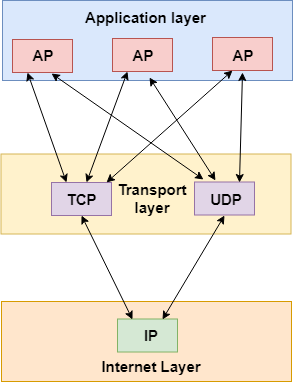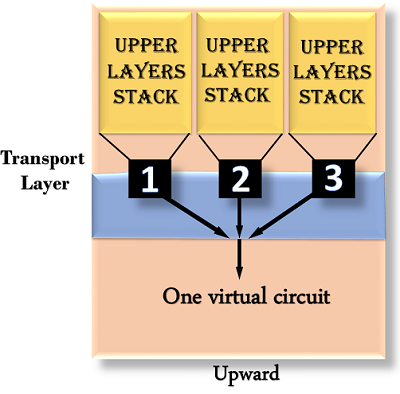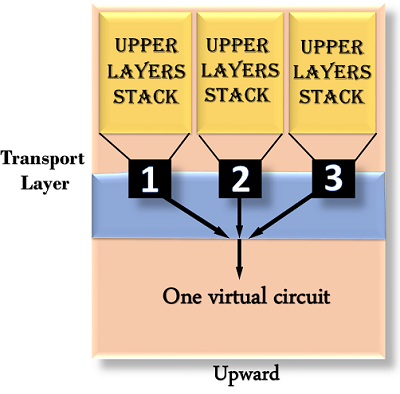UNIT 10
Introduction to transport layer
Transport Layer
- From the top the transportation layer is the fourth layer.
- The transport layer main role is to provide the communication services directly to that of application processes running on different hosts.
- It provides a logical communication between application processes which is running on different hosts. Although the application processes on many different hosts are not at all physically connected, application processes use the logical communication which is provided by the transport layer to send the messages to each other.
- The transport layer protocols are to be implemented in the end systems but are not implemented in the network routers.
- A computer network provides more than one protocol to each of the network applications. Such as TCP and UDP are two transport layer protocols which provide a different set of services to the network layer.
- All transport layer protocols going to provide multiplexing/DE multiplexing service. It also provides other services for example reliable data transfer, bandwidth guarantees, and delay guarantees.
- The application layer of each of the applications has the ability to send a message by using TCP or UDP. Either of these two protocols is used for the application communication. Both TCP and UDP will then be able to communicate with the internet protocol in the internet layer. The applications can read and write to the transport layer. Thus, we can say that communication is a two-way process.

Services provided by the Transport Layer
The services provided by the transport layer are same as the data link layer. The data link layer provides the services within one network while that of transport layer provides the services across an inter network made up of many networks. The data link layer controls the physical layer while that of the transport layer controls all the lower layers.
The services provided by the transport layer protocols are as follows:
- End-to-end delivery
- Addressing
- Reliable delivery
- Flow control
- Multiplexing

End-to-end delivery:
The entire message of the transport layer transmits to the destination. Therefore, it ensures the end-to-end delivery of an entire message from the source to the destination.
Reliable delivery:
The transport layer provides reliability services by retransmitting the lost and damaged packets.
The reliable delivery has four aspects as shown:
- Error control
- Sequence control
- Loss control
- Duplication control

Flow Control
Flow control is used to prevent the sender from overwhelming the receiver. If the receiver is overloaded with very much data, then the receiver will discards the packets and asking for the retransmission of packets. This increases network congestion and thus, reducing the system performance. The transport layer is responsible for the flow control. It uses the sliding window protocol that makes the data transmission more efficient as well as it controls the flow of data so that the receiver does not become overwhelmed. Sliding window protocol is the byte oriented protocol rather than that of the frame oriented protocol.
Multiplexing
The transport layer uses the multiplexing to improve the transmission efficiency.
Multiplexing can occur in two ways as shown below:
- Upward multiplexing: In Upward multiplexing multiple transport layer connections uses the same network connection. To make more cost-effective, the transport layer sends many transmissions bound for that of the same destination along with the same path; this is achieved through the upward multiplexing.

- Downward multiplexing: In Downward multiplexing one transport layer connection uses more than one network connections. Downward multiplexing allows the transport layer to split a connection into many paths to improve the throughput. This type of multiplexing is used when the networks have low or slow capacity.

Addressing
- According to the layered model, the transport layer will interacts with many of the functions of the session layer. Many protocols combine session layer, presentation layer, and application layer protocols into one layer which is known as the application layer. In these cases, delivery to the session layer is same as the delivery to the application layer. Data generated by an application on one of the machine must be transmitted to the correctly to the application on another machine. In this case, addressing is provided by that of the transport layer.
- The transport layer provides the user address which is to be specified as a station or the port. The port variable represents a particular TS user of a specified station called as a Transport Service access point (TSAP). Each station has only one of the transport entities.
- The transport layer protocols need to know which of the upper-layer protocols are communicating.
Introduction
Layer 3 or the Network layer uses IP or Internet Protocol which is a connection less protocol and treats every single packet individually and separately which leads to lack of reliability during a transmission. For example, when data is sent from one host to the other host, each packet may take a different path even if it belongs to the same session. This means the packets may/may not arrive in the right order. Therefore, IP relies on the higher layer protocols to provide reliability.
TCP (Transmission Control Protocol):
TCP is a layer 4 protocol which provides information of the received packets and is also reliable as it sends again the lost packets. It is far better than UDP but due to these features it has an additional overhead. It is used by application protocols like HTTP and FTP.
UDP (User Datagram Protocol):
UDP is also a layer 4 protocol but unlike TCP it doesn’t provide information of the sent packets. Therefore, it is not reliable and also depends on the higher layer protocols for the same. But on the other hand it is very simple, scalable and comes with very less overhead as compared to TCP. For example: it is used in video and voice streaming.
TCP Vs UDP –
- Session Multiplexing:
One host with one IP address is able to communicate with more than one servers. While using TCP, first a connection must be established between the server and the receiver end and then the connection is closed immediately when the transfer is completed. TCP also maintains the reliability while the transfer is taking place.
UDP on the other hand sends no information of receiving the packets. Therefore, provides no reliability.
2. Segmentation:
Information sent is first broken into smaller pieces for transmission.
Maximum Transmission Unit or MTU of a Fast Ethernet is 1500 bytes whereas the theoretical value of TCP is 65495 bytes. Therefore, data has to be broken into very small pieces before it has being sent to the lower layers. MSS or Maximum Segment Size should be set small enough to avoid fragmentation. TCP supports MSS and Path MTU discovery with which the sender and the receiver can automatically determine the maximum transmission capability.
UDP doesn’t support this; therefore it depends on the higher layer protocols for data segmentation.
3. Flow Control:
If sender sends data very fast than what receiver can process then the receiver end will drop the data and then request again for transmission, This will lead to waste of time and resources both. TCP provides end-to-end flow control which is realized by using the sliding window. The sliding window sends an acknowledgement from receiver’s end regarding the data that the receiver can receive at a time.
UDP does not implement flow control and depends on the higher layer protocols for the same.
4. Connection Oriented:
TCP is connection oriented, that is it creates a new connection for the transmission to takes place, and once the transfer is over then that connection will be terminated.
UDP on the other hand is connectionless just like IP (Internet Protocol).
5. Reliability:
TCP sends an acknowledgement when a packet is received. It requests a retransmission when packet is lost.
UDP relies on the higher side of the layer protocols for the same.
References:
- Data Communication & Networking by Forouzan, Tata McGraw Hill.
- Computer Network, 4e, by Andrew S. Tenenbaum, Pearson Education/ PHI.
- Data Communication and Computer Networks, by Prakash C.Gupta, PHI.
- Networking Ali-in-one Desk Reference by Doug Lowe, Wiley Dreamtech
- Computer Networking: A Top-Down Approach featuring the Internet, 3e by James F.Kurose.
- Computer Network by Godbole, Tata McGraw Hill.
- Computer Networking, by Stanford H. Rowe, Marsha L. Schuh
UNIT 10
Introduction to transport layer
Transport Layer
- From the top the transportation layer is the fourth layer.
- The transport layer main role is to provide the communication services directly to that of application processes running on different hosts.
- It provides a logical communication between application processes which is running on different hosts. Although the application processes on many different hosts are not at all physically connected, application processes use the logical communication which is provided by the transport layer to send the messages to each other.
- The transport layer protocols are to be implemented in the end systems but are not implemented in the network routers.
- A computer network provides more than one protocol to each of the network applications. Such as TCP and UDP are two transport layer protocols which provide a different set of services to the network layer.
- All transport layer protocols going to provide multiplexing/DE multiplexing service. It also provides other services for example reliable data transfer, bandwidth guarantees, and delay guarantees.
- The application layer of each of the applications has the ability to send a message by using TCP or UDP. Either of these two protocols is used for the application communication. Both TCP and UDP will then be able to communicate with the internet protocol in the internet layer. The applications can read and write to the transport layer. Thus, we can say that communication is a two-way process.

Services provided by the Transport Layer
The services provided by the transport layer are same as the data link layer. The data link layer provides the services within one network while that of transport layer provides the services across an inter network made up of many networks. The data link layer controls the physical layer while that of the transport layer controls all the lower layers.
The services provided by the transport layer protocols are as follows:
- End-to-end delivery
- Addressing
- Reliable delivery
- Flow control
- Multiplexing

End-to-end delivery:
The entire message of the transport layer transmits to the destination. Therefore, it ensures the end-to-end delivery of an entire message from the source to the destination.
Reliable delivery:
The transport layer provides reliability services by retransmitting the lost and damaged packets.
The reliable delivery has four aspects as shown:
- Error control
- Sequence control
- Loss control
- Duplication control

Flow Control
Flow control is used to prevent the sender from overwhelming the receiver. If the receiver is overloaded with very much data, then the receiver will discards the packets and asking for the retransmission of packets. This increases network congestion and thus, reducing the system performance. The transport layer is responsible for the flow control. It uses the sliding window protocol that makes the data transmission more efficient as well as it controls the flow of data so that the receiver does not become overwhelmed. Sliding window protocol is the byte oriented protocol rather than that of the frame oriented protocol.
Multiplexing
The transport layer uses the multiplexing to improve the transmission efficiency.
Multiplexing can occur in two ways as shown below:
- Upward multiplexing: In Upward multiplexing multiple transport layer connections uses the same network connection. To make more cost-effective, the transport layer sends many transmissions bound for that of the same destination along with the same path; this is achieved through the upward multiplexing.

- Downward multiplexing: In Downward multiplexing one transport layer connection uses more than one network connections. Downward multiplexing allows the transport layer to split a connection into many paths to improve the throughput. This type of multiplexing is used when the networks have low or slow capacity.

Addressing
- According to the layered model, the transport layer will interacts with many of the functions of the session layer. Many protocols combine session layer, presentation layer, and application layer protocols into one layer which is known as the application layer. In these cases, delivery to the session layer is same as the delivery to the application layer. Data generated by an application on one of the machine must be transmitted to the correctly to the application on another machine. In this case, addressing is provided by that of the transport layer.
- The transport layer provides the user address which is to be specified as a station or the port. The port variable represents a particular TS user of a specified station called as a Transport Service access point (TSAP). Each station has only one of the transport entities.
- The transport layer protocols need to know which of the upper-layer protocols are communicating.
Introduction
Layer 3 or the Network layer uses IP or Internet Protocol which is a connection less protocol and treats every single packet individually and separately which leads to lack of reliability during a transmission. For example, when data is sent from one host to the other host, each packet may take a different path even if it belongs to the same session. This means the packets may/may not arrive in the right order. Therefore, IP relies on the higher layer protocols to provide reliability.
TCP (Transmission Control Protocol):
TCP is a layer 4 protocol which provides information of the received packets and is also reliable as it sends again the lost packets. It is far better than UDP but due to these features it has an additional overhead. It is used by application protocols like HTTP and FTP.
UDP (User Datagram Protocol):
UDP is also a layer 4 protocol but unlike TCP it doesn’t provide information of the sent packets. Therefore, it is not reliable and also depends on the higher layer protocols for the same. But on the other hand it is very simple, scalable and comes with very less overhead as compared to TCP. For example: it is used in video and voice streaming.
TCP Vs UDP –
- Session Multiplexing:
One host with one IP address is able to communicate with more than one servers. While using TCP, first a connection must be established between the server and the receiver end and then the connection is closed immediately when the transfer is completed. TCP also maintains the reliability while the transfer is taking place.
UDP on the other hand sends no information of receiving the packets. Therefore, provides no reliability.
2. Segmentation:
Information sent is first broken into smaller pieces for transmission.
Maximum Transmission Unit or MTU of a Fast Ethernet is 1500 bytes whereas the theoretical value of TCP is 65495 bytes. Therefore, data has to be broken into very small pieces before it has being sent to the lower layers. MSS or Maximum Segment Size should be set small enough to avoid fragmentation. TCP supports MSS and Path MTU discovery with which the sender and the receiver can automatically determine the maximum transmission capability.
UDP doesn’t support this; therefore it depends on the higher layer protocols for data segmentation.
3. Flow Control:
If sender sends data very fast than what receiver can process then the receiver end will drop the data and then request again for transmission, This will lead to waste of time and resources both. TCP provides end-to-end flow control which is realized by using the sliding window. The sliding window sends an acknowledgement from receiver’s end regarding the data that the receiver can receive at a time.
UDP does not implement flow control and depends on the higher layer protocols for the same.
4. Connection Oriented:
TCP is connection oriented, that is it creates a new connection for the transmission to takes place, and once the transfer is over then that connection will be terminated.
UDP on the other hand is connectionless just like IP (Internet Protocol).
5. Reliability:
TCP sends an acknowledgement when a packet is received. It requests a retransmission when packet is lost.
UDP relies on the higher side of the layer protocols for the same.
References:
- Data Communication & Networking by Forouzan, Tata McGraw Hill.
- Computer Network, 4e, by Andrew S. Tenenbaum, Pearson Education/ PHI.
- Data Communication and Computer Networks, by Prakash C.Gupta, PHI.
- Networking Ali-in-one Desk Reference by Doug Lowe, Wiley Dreamtech
- Computer Networking: A Top-Down Approach featuring the Internet, 3e by James F.Kurose.
- Computer Network by Godbole, Tata McGraw Hill.
- Computer Networking, by Stanford H. Rowe, Marsha L. Schuh